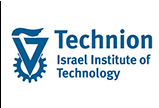Students
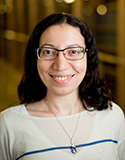 Nesreen Ahmed, Ph.D. Candidate
Nesreen Ahmed, Ph.D. Candidate
Department of Computer Science
Purdue University
Research Area: Graph Analytics in the Age of Big Data
Big data and, in particular, network data that represent human behavior is becoming important for business decisions, detecting product trends, and making predictions. One key stumbling block for enabling big graph analytics is the limitation in computational resources. Despite the recent advances in distributed and parallel processing frameworks for graph analytics (e.g. MapReduce) and the appearance of infinite resources in the cloud, running brute-force graph analytics (e.g., counting triangles) is too costly, too slow, or too inefficient in many practical situations. On the other hand, finding an approximate answer is usually sufficient for many types of analyses, for which the extra cost and time of finding the exact answer is often not worth the extra accuracy. In these cases, sampling provides an attractive approach to quickly and efficiently find an approximate answer to a query, or more generally, any graph analysis objective. However, recently it has been noted that big data may not imply better analytics or predictions, especially if it is collected wrong or the sampling bias is totally ignored. For these reasons, a more thorough understanding of network sampling is critical to support the field of network science. Much of the research on network sampling has focused primarily on sampling from static graphs – while little attention was given to sampling from massive disk-resident and graph streams. Therefore, we designed a generic stream sampling framework for big graph analytics, called Graph Sample and Hold (gSH), which samples from massive graphs sequentially in a single pass, one edge at a time, while maintaining a small state in memory. Our sample and hold framework facilitates the accurate estimation of subgraph counts by enabling the dependence of the sampling process to vary based on the sampled state. Within our framework, we show how to produce statistically unbiased estimators for various graph properties from the sample. Given that the graph analytics will run on a sample instead of on the whole population, the runtime complexity is kept under control. Moreover, given that the estimators are unbiased, the approximation error is also kept under control. Finally, we test the performance of the proposed framework (gSH) on various types of graphs, showing that from a sample with < 40K edges, it produces estimates with relative errors < 1%.
Nesreen Ahmed is a Ph.D. candidate in the Department of Computer Science at Purdue University. Her research interests in data mining focuses on the design of efficient and scalable algorithms for mining large dynamic graphs, with a particular emphasis on statistical learning, sampling, and estimation of streaming graphs. Nesreen received a Master’s degree in Computer Science from Cairo University and another Master’s degree in Statistics and Computer Science from Purdue University. She also received her B.S. from Cairo University, where she was awarded the 2nd rank in the department. While at Purdue, she has given tutorials at SIGKDD and ICDM. She has worked as a visiting research assistant at Facebook data science, Adobe Advanced Technology Labs, Intel data analytics, and the data mining and computer modeling center of excellence in Cairo. Over the last five years, she has co-authored 10+ international conferences and refereed journal publications, and 2 US patents.
 Atiyah Ahsan, Ph.D. Candidate
Atiyah Ahsan, Ph.D. Candidate
Lightwave Research Laboratory
Columbia University
Research Area: Advanced Optical Performance Monitoring for Next-Generation Dynamic Optical Networks
Ever-growing demand for speed and bandwidth and increasing energy consumption in today’s networks are driving the need for intelligent, next-generation networking architectures that can overcome fundamental spectral and energy limitations. Metro-only internet traffic in, particular, is experiencing unprecedented growth and is projected to exceed long-haul traffic by 40% in 2017; current static peak capacity provisioned networks are ill-equipped to address such “bursty” traffic patterns. Dynamic optical networking, where bandwidth is allocated on-demand in the physical layer in response to changing traffic demands and network conditions, is a promising solution to address these challenges. Rapidly changing network configurations, however, cause unpredictable transmission impairments and result in network instability. Real-time awareness of the state of the physical layer is necessary for managing signal quality and reliability in a dynamic network and can be achieved through ubiquitous distribution of advanced optical performance monitors in a network. Delay-line-interferometer (DLI) based optical-signal-to-noise (OSNR) monitor is a good candidate for ubiquitous monitoring as it is cost-effective and supports multiple advanced modulation formats. Its greatest drawback is that its measurements are modulation-format and bit-rate dependent, rendering it ineffective in future networks operating in a mixed line rate and modulation formats framework. In our recent work, we demonstrated that by using pilot-tones, modulation-format and bit-rate awareness is realized in the monitor. Autonomous signal quality decisions, even in the presence of modulationdependent cross-talk, is achieved, facilitating scalable cross-layer impairment aware routing.
Atiyah Ahsan received the B.Sc. degree in electrical engineering (summa cum laude, thesis with highest honors) from Tufts University, Boston and the M.Sc. degree from Columbia University, New York in 2010 and 2012 respectively. From May 2012 to January 2013, she worked as a student collaborator on a project led by Dr. Daniel Kilper at Bell Labs Alcatel Lucent. She is currently a Ph.D. candidate at the Columbia University Lightwave Research Laboratory under the advisement of Professor Keren Bergman. Her research is focused on advanced optical performance monitoring techniques and cross-layer architectures for next-generation dynamic access and metro-networks.
 Mahnoosh Alizadeh, Postdoctoral Scholar
Mahnoosh Alizadeh, Postdoctoral Scholar
Electrical Engineering
Stanford University
Research Area: Reduced-order Models for the Demand Response Problem
To respond to volatility and congestion in the power grid, demand response (DR) mechanisms allow for shaping the load compared to a base load profile. Applying DR mechanisms to the residential and commercial sectors would require tapping into a large population of heterogeneous appliances. The challenge here is in modeling the dimensions available for control and implementing them in real time. Due to the scale of the problem, such models need to strike the right balance between accuracy and tractability. The goal of this research is to provide a medium-grained stochastic hybrid model to represent a large population of appliances that belong to two classes: deferrable or thermostatically controlled loads. We preserve quantized information regarding individual load constraints, while discarding information about the identity of appliance owners. The advantages of our reduced-order population model are 1) it allows us to model and control load in a scalable fashion, useful for ex-ante planning by an aggregator, real-time load control, and economic compensation; 2) it allows for the preservation of the privacy of end-use customers who own submetered or directly controlled appliances.
Mahnoosh Alizadeh is a postdoctoral scholar in the Electrical Engineering department of Stanford University. She received the B.Sc. degree in Electrical Engineering from Sharif University of Technology in 2009 and her Ph.D. in Electrical and Computer Engineering from University of California, Davis in 2014. Her research interests mainly lie in the area of modeling, real-time control, and optimization for smart cyber-physical systems, particularly the power grid and intelligent electric transportation networks.
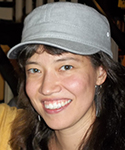 Elaine Angelino, Miller Postdoctoral Fellow
Elaine Angelino, Miller Postdoctoral Fellow
Computer Science
UC Berkeley
Research Area: Accelerating Markov chain Monte Carlo via parallel predictive prefetching
Probabilistic models provide a framework for uncovering structure in data. This structure is what enables us to do useful things with data, such as gain insight into processes that generate observations and make predictions about the future. Inference is the process of estimating structure in data via probabilistic modeling. In particular, Bayesian inference uses Bayes’ rule to update a probabilistic description of model parameters as more data are observed. Markov chain Monte Carlo (MCMC) is a powerful class of inference algorithms used in machine learning problems. Unfortunately, these algorithms are typically slow to converge, so they must be run for many iterations before they yield useful output. Furthermore, they are inherently serial and thus, in general, do not parallelize well. We present parallel predictive prefetching, a general framework for accelerating a large class of widely-used MCMC algorithms. It speculatively evaluates many potential steps of an MCMC chain in parallel while exploiting fast, iterative approximations to the target density. This can accelerate sampling from target distributions in Bayesian inference problems. Our approach takes advantage of whatever parallel resources are available, but produces results exactly equivalent to standard serial execution. In the initial phase of chain evaluation, we achieve speedup close to linear in the number of available cores. This work is part of a recent trend in machine learning to develop new algorithms by adapting ideas from the systems community.
Elaine Angelino is a Miller Fellow at UC Berkeley, where her faculty host is Michael I. Jordan, and she is a member of the AMPLab. Her research is focused on developing new algorithms and theory for large-scale inference. She is also particularly interested in Markov chains, both as inferential and modeling tools. She recently completed her Ph.D. in Computer Science at Harvard University, where she worked with Margo Seltzer, Ryan P. Adams, and Eddie Kohler. In her graduate research, she studied frameworks for using speculative execution to transform serial algorithms into parallel algorithms.
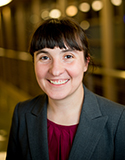 Tamara Bonaci, Ph.D. Candidate
Tamara Bonaci, Ph.D. Candidate
Department of Electrical Engineering, BioRobotics Lab
University of Washington
Research Area: Privacy and Security by Design in Brain-Computer Interfaces
Privacy and Security by Design in Brain-Computer Interfaces
A Brain-Computer Interface (BCI) is a communication system between the brain and the physical environment. Recent experimental results show how electroencephalograms (EEG), obtained using consumer-grade BCIs, can be used to extract private information about users. This information can be exploited and misused to infer information about users’ memory, intentions, conscious and unconscious interests, as well as emotional reactions. Privacy and security issues arising from the misuse of BCIs represent an emerging problem that deserves careful consideration.
In this research project, we propose that elements of a person’s electro-physiological signals can be used to extract private information. This hypothesis is being tested through a series of experiments involving human participants. The recorded signals are being analyzed to identify which signal components can be used for extraction, and to quantify exposure risk through information-theoretic metrics. Of particular interest are Event Related Potential (ERP) components of EEG signals, which are known to occur as responses to a variety of stimuli. As the next step of the project, we are designing, developing and validating a tool to enhance privacy and security of brain-computer interfaces, which we refer to as the BCI Anonymizer. It is a signal processing tool that decomposes users’ signals into components, in order to grant access to the information corresponding to users’ intended BCI commands while preventing anyone from accessing their private information.
Tamara Bonaci is a Ph.D. candidate at the University of Washington, Department of Electrical Engineering. She received her B.S. degree from the University of Zagreb, Croatia and her M.S. degree from the University of Washington. Tamara’s research focuses on security and privacy of cyber-physical systems with humans in the loop. She is currently involved with two projects, investigating privacy and security issues of neural technologies, such as brain-computer interfaces, and improving security of teleoperated robots. In the area of neural privacy and security, Tamara is working towards understanding and quantifying the amount of private information that can be extracted using a person’s neural and skeletal muscles’ signals as information sources. She is researching and developing a signal processing tool, referred to as the BCI Anonymizer, which will be used to prevent and mitigate these privacy attacks. In the area of teleoperated security, Tamara is researching potential security threats against the next-generation teleoperated robotic systems. She is working towards quantifying the impact of these threats on remote operators, robots, as well as teleoperated procedures as a whole. She is researching and developing a set of mitigation strategies against identified attacks, which rely on physical knowledge about the system.
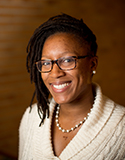 LaVonda Brown, Ph.D. Candidate
LaVonda Brown, Ph.D. Candidate
Electrical & Computer Engineering
Georgia Institute of Technology
Research Area: Developing an Engagement and Social Interaction Model for a Robotic Educational Agent
Effective educational agents should accomplish two essential goals during the learning process 1) monitor engagement of the student during the interaction and 2) apply behavioral strategies to maintain the student's attention when engagement decreases. In this research, we focus on both of these objectives through use of an interactive teaching device to display the learning task (a handheld tablet or computer) and a robotic educational agent to monitor and re-engage the student. We begin by developing an engagement model based on the interactions between the student and the device. We then create a framework for implementing nonverbal, or gestural, behaviors on a humanoid robot and evaluate its perception and effectiveness for social interaction. Next, we embed several verbal behaviors on the robot and observe the effect it has on a learning scenario. Finally, we describe and evaluate the entire educational system that uses the preliminary engagement model running on the interactive learning device to activate the various behavioral strategies embedded on the robotic educational agent.
LaVonda Brown received her Bachelor of Science in Electronics Engineering in 2010 from Norfolk State University in Norfolk, VA. She received her Master of Science in Electrical & Computer Engineering (ECE) in 2012 from Georgia Institute of Technology in Atlanta, GA. She is currently an ECE Ph.D. Candidate at Georgia Tech, studying the effect of social robots on human engagement when learning tasks.
 Cathy Chen, Ph.D. Candidate
Cathy Chen, Ph.D. Candidate
Electrical Engineering
Columbia University
Research Area: A Photonic Interconnection Network for Hardware Accelerator Enabled Heterogeneous Utility Computing
High-bandwidth connectivity provided by Wavelength Division Multiplexing (WDM) optical interconnects is an important enabler for delocalized hardware accelerators in heterogeneous utility computing. In this work, we propose and validate an architecture for optically connected hardware accelerators with experiments that leverage optical interconnects to demonstrate the active switching and multicasting of Field Programmable Gate Array (FPGA) generated and received optical packets.
Cathy Chen received her BS in Electrical and Computer Engineering, with a minor in Asian Studies from Cornell University in Ithaca, NY in 2009. She received her MS and M.Phil in Electrical Engineering from Columbia University in 2011 and 2013 respectively. Cathy is a recipient of Columbia University's School of Engineering and Applied Sciences Grossman Scholarship as well as the Wei Family Foundation Scholarship. Her current research interests are next generation optical networks for data centers and FPGA development for optical interconnects. Her interests include photography, rock climbing, and travel.
 Canan Dagdeviren, Ph.D. Candidate
Canan Dagdeviren, Ph.D. Candidate
Materials Science and Engineering
University of Illinois at Urbana-Champaign
Research Area: New Generation Medical Devices with Self-Powering ‘Unusual’ Electronics
Implantable medical devices have made a major impact in improving healthcare. Increasingly in recent years, devices have become active rather than passive – for example cardiac pacemakers. A key challenge for these active systems, as well as for others on the horizon is their need for an internal electrical power source. A downside of present systems is the limitation of internal batteries, which must be changed frequently, requiring follow-up surgical procedures, with associated complication risks and additional healthcare costs. One compelling solution would be to employ energy harvesting as a means of recharging or completely replacing batteries. Energy harvesting, through chemical reactions, heat extraction, blood flow, and natural mechanical movements of organs, could help address energy depletion in implants. However, most harvesting units being considered today are like conventional batteries, in that they also rely on rigid electronics and subcomponents, and therefore, are incapable of providing intimate mechanical contact with soft tissue. In this study, materials and devices that enable high efficiency mechanical to electrical energy conversion from the natural contractile and relaxation motion of the heart, lung and diaphragm, demonstrated in several different animal models, each of which has organs with sizes that approach human scales are reported. A combination of such energy harvesting elements with rectifiers and microbatteries provides an entire flexible system, conformable, capable of viable integration with the beating heart via medical sutures and operation with efficiency of ~2%. Additionally, in vitro experiments, computational models and results in multilayer configurations capture the key behaviors, illuminate crucial design features and provide sufficient power outputs for operation of pacemakers, with or without battery assist.
Canan Dagdeviren was born on 4th of May, 1985 in Istanbul. She has been fascinated by science ever since she was a child. By the influence of Prof. Erdal İnönü, she decided to study physics and obtained her B.Sc. in Physics Engineering from Hacettepe University. She was awarded with full-scholarship throughout her M.Sc. studies in Materials Science and Engineering at Sabanci University. Dagdeviren was the top of the list in her field to be entitled to a Fulbright Doctoral Fellow, which was given for the first time in Turkey in 2009, and she pursues her Ph.D. in Material Science and Engineering at the University of Illinois at Urbana-Champaign under supervision of Prof. John A. Rogers. The primary focuses of her research are applications of ferroelectric/piezoelectric materials and patterning techniques for unusual electronics with an emphasis on bio-inspired and bio-integrated systems, such as bio-sensors, actuators, transducers, and mechanical energy harvesters in flexible/stretchable forms. She is expected to receive her Ph.D. in Dec., 2014. Dagdeviren serves as a research assistant in Frederick Seitz Materials Research Laboratory, Beckman Institute for Advanced Science and Technology. Currently, she has 14 journal papers, is inventor on 2 patent applications, and holds over 25 prestigious awards. Recently, she has been selected as the innovator of the year among the first generation innovators of MIT Technology Review Innovators Under 35 Turkey (default candidate of TR35 Global 2015).
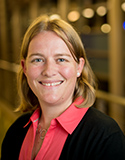 Nicola Dell, Ph.D. Candidate
Nicola Dell, Ph.D. Candidate
Computer Science and Engineering
University of Washington
Research Area: Mobile Camera-Based Systems for Resource-Constrained Environments
My research aims to improve the lives of underserved populations by identifying and overcoming the problems associated with deploying and sustaining mobile systems in remote areas. Specifically, my Ph.D. thesis explores the technical, user interaction and deployment challenges of integrating mobile, camera-based systems into resource-constrained environments, with the goal of alleviating some of the challenges currently faced by health workers in remote settings. I focus on two application domains relevant to health worker programs: automatically interpreting diagnostic tests for infectious diseases, and automatically digitizing data from paper forms, and employ a common approach to interpreting camera-based input for both these domains. I evaluate my work through extensive field evaluations with health workers in sub-Saharan Africa and highlight the feasibility, benefits and challenges of using camera-based systems to aid in the delivery of health and information services to underserved populations.
Nicola Dell is a Ph.D. Candidate in Computer Science and Engineering at the University of Washington in Seattle. Her research interests lie in computing for development, human-computer interaction and mobile computing with a focus on designing and evaluating systems that improve the lives of underserved populations in low-income regions. In particular, her PhD thesis focuses on the technical, user interaction and deployment challenges of integrating mobile, camera-based systems into resource-constrained environments.
Nicki obtained a B.S. in Computer Science from the University of East Anglia (UK) in 2004 and an M.S. in Computer Science and Engineering from the University of Washington in 2011. Nicki has won several awards and fellowships, including a Graduate Facebook Fellowship and a Google Anita Borg Scholarship. She has completed internships at Microsoft Research in Redmond, USA and in Bangalore, India and has led the Change group at the University of Washington since 2011.
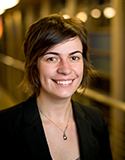 Anca Dragan, Ph.D. Candidate
Anca Dragan, Ph.D. Candidate
Robotics Institute
Carnegie Mellon University
Research Area: Robot Motion for Seamless Human-Robot Collaboration
The goal of my research is to enable robots to autonomously produce behavior for seamless interactions and collaborations with everyday people. I aim to develop a formal understanding of interaction that leads to robotics algorithms which are informed by mathematical models of how people will interact with them, and which generalize across robot morphologies and interaction modalities.
My thesis work focuses on generating motion for collaboration. Most motion in robotics is purely functional: industrial robots move to package parts, vacuuming robots move to suck dust, and personal robots move to clean up a dirty table. This type of motion is ideal when the robot is performing a task in isolation. Collaboration, however, does not happen in isolation, and demands that we move beyond purely functional motion. In collaboration, the robot's motion has an observer, watching and interpreting the motion – inferring the robot's intent from the motion, and anticipating the robot's motion based on its intent. My work develops a mathematical model of these inferences, and integrates this model into motion planning, so that the robot can generate motion that matches people's expectations and clearly conveys its intent. In doing so, I draw on action interpretation theory, Bayesian inference, constrained trajectory optimization, and interactive learning. The resulting motion not only leads to more efficient collaboration, but also increases the fluency of the human-robot team as defined through both objective and subjective measures.
Anca Dragan is a Ph.D. candidate at Carnegie Mellon's Robotics Institute, and a member of the Personal Robotics Lab. She was born in Romania and received her B.Sc. in Computer Science from Jacobs University Bremen in 2009. Her research lies at the intersection of robotics, machine learning, and human-computer interaction: she is interested in enabling robots to seamlessly work with and around people. Anca is a Siebel Scholar for 2014, was an Intel PhD Fellow in 2013, a Google Anita Borg scholar in 2012, and serves as General Chair for Carnegie Mellon’s Quality of Life Technology Center's Student Council.
 Lauren Cairco Dukes, Ph.D. Candidate
Lauren Cairco Dukes, Ph.D. Candidate
School of Computing
Clemson University
Research Area: Development of a Scenario Builder Tool for Scaffolded Virtual Patients
During their baccalaureate education, nursing students have limited opportunities to practice interaction with patients . Traditional training for patient interaction includes roleplay with peers, and practice interviews with paid actors. Unfortunately, neither of these methods adequately portrays the wide range of patients and medical conditions that nurses encounter in their clinical experiences. Virtual patients can provide realistic yet repetitive practice in patient interaction, since they can represent a wide range of patients, and each scenario can be practiced until the student achieves competency. However, there are two problems with existing virtual patient platforms: (1) cost of development, since creation of a single scenario may take up to nine months, and (2) lack of extensibility, since a scenario is typically only targeted towards a single set of learning goals and learners. In this work, I propose potential solutions to these two problems: (1) the user-centered design and creation of a scenario-builder tool to enable nursing faculty to create their own scenarios, and (2) user testing of a system to present a single scenario in ways appropriate for multiple levels of learners.
Lauren Cairco Dukes is a Ph.D. Candidate in computer science at the School of Computing at Clemson University. She earned her B.S. in computer science from Winthrop University in 2005, and her M.S. in computer science with concentrations in graphics and algorithms from Clemson University in 2012. Her research focuses on creating usable, efficient ways for domain experts to create virtual reality training experiences without the aid of computer scientists. She is interested in virtual characters, educational applications, and human computer interaction. Her advisor is Dr. Larry Hodges. In addition to her research, Lauren also enjoys teaching and has taught three undergraduate courses. Lauren is an NSF Graduate Research Fellow, has received the outstanding master’s and Ph.D. Student of the Year awards in the Clemson University School of Computing, and has completed internships at Charles River Analytics and at the University of Southern California Institute for Creative Technologies. After graduation, Lauren plans on pursuing a job in academia.
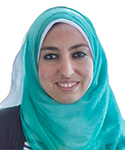 Dina El-Damak, Ph.D. Candidate
Dina El-Damak, Ph.D. Candidate
Department of Electrical Engineering and Computer Science
MIT
Research Area: Energy-Efficient Power Processing Circuits for Autonomous Sensors and Wearable Devices
Self-powered sensors and wearable electronics are currently of great interest in a wide span of domains, including personalized medical health care, fitness, and ambient monitoring. Since the system size does not allow the integration of a large energy storage device, extreme energy efficiency of the power management circuits is crucial for extended operation time. This requires innovation across all aspects of the design, from the system architecture to circuit style and technology. Thus, our work focuses on an energy harvesting system with nearly 1nA of quiescent current. The system supports dual output for battery charging and output voltage regulation as well as self-startup. The second part focuses on technology aspects where the design of a Ferroelectric Capacitor (Fe-Cap) based DC-DC converter is presented. It achieves a 93% peak efficiency while integrating the flying capacitors. Measurement results demonstrating fully-functional prototypes will be shown and future application opportunities will be discussed.
Dina El-Damak received the B.Sc. and M.Sc. degrees in Electronics and Electrical Communication Engineering from Ain Shams University, Cairo, Egypt in 2007 and 2010 respectively and the S.M. degree in Electrical Engineering and Computer Science from the Massachusetts Institute of Technology (MIT), Cambridge, MA in 2012. She is currently a Ph.D. candidate in the Energy-Efficient Circuits and Systems group at MIT, working under the supervision of Prof. Anantha Chandrakasan. She was a design engineer intern at Texas Instruments Kilby Labs, Dallas, TX, for the summers of 2012 and 2013, working on the design of isolated power converters and current sensing circuits. Ms. El-Damak is the recipient of the Texas Instruments Graduate Women’s Fellowship for Leadership in Microelectronics for the academic years 2012-2013 and 2013-2014. Her research interests include energy harvesting, switched capacitor DC-DC Converters design and power management circuits for energy-efficient systems.
 Vidya Ganapati, Ph.D. Candidate
Vidya Ganapati, Ph.D. Candidate
Electrical Engineering
UC Berkeley
Research Area: Photon Management in Energy Conversion
In order to reach theoretical limiting efficiencies with photovoltaics, careful management of photons is crucial. In this work, the optical design of solar cells is computationally analyzed. We propose and evaluate practical designs for reaching thermodynamic efficiency limits, including intermediate air gaps for improving the efficiency of multi-bandgap solar cells and nano-surface textures for ultrathin cells. We extend our results to thermophotovoltaics (any heat source to electricity conversion via photovoltaic cells), showing that high efficiencies are possible with careful design of mirrors on the backsides of the cells.
Vidya Ganapati is a Ph.D. candidate at the University of California, Berkeley, advised by Prof. Eli Yablonovitch. She graduated with a bachelor’s degree in Electrical Engineering from the Massachusetts Institute of Technology in 2010. Her current research interests focus around the optics of solar cells, thermophotovoltaics, and electromagnetic optimization techniques. She is a recipient of the Department of Energy Office of Science Graduate Fellowship and the UC Berkeley Chancellor’s Fellowship.
 Stephanie Gil, Postdoctoral Associate
Stephanie Gil, Postdoctoral Associate
Distributed Robotics Lab CSAIL
MIT
Research Area: Communication-aware Robotic Systems
Recent advances in communication are enabling new solutions to long-standing problems in robotics. Of current interest in the robotics literature are multi-agent teams for their applications to distributed exploration, search and rescue, and, in the near future, global connectivity. The effectiveness of these coordinated systems hinges on the assumption of adequate inter-agent communication. Our research focuses on novel algorithms and tools at the intersection of robotics and communication. In particular, we demonstrate solutions for a wide array of challenges inherent to robot teams including i) establishing and maintaining connectivity of multi-agent networks for global connectivity applications, ii) using wireless signals for accurate motion tracking indoors and iii) using communication to detect and immunize against cyber-security attacks for robotic swarms. We obtain a variety of results from actual implementation: ranging from a team of robot routers that adapt their formation to support requested data rates over long distances, to an algorithm that uses wireless signals for measuring the position of a transmitting device (or robot) to within tens of centimeters.
Stephanie Gil is a postdoctoral associate with Prof. Daniela Rus in the Distributed Robotics Lab at MIT. Her research interests are in multi-robot control, distributed optimization of ad hoc communication networks, and space robotics. She completed her Ph.D. in CSAIL (the Computer Science and Artificial Intelligence Lab) at MIT, her M.S. in Aeronautics and Astronautics at MIT, and her B.S. in Mechanical Engineering at Cornell, where she also worked on the NASA Mars Exploration Rover team.
 Georgia Gkioxari, Ph.D. Candidate
Georgia Gkioxari, Ph.D. Candidate
EECS
UC Berkeley
Research Area: Detecting people, their pose and action in the wild
We present convolutional neural networks for the tasks of keypoint (pose) prediction and action classification of people in unconstrained images. Our approach involves training an R-CNN detector with loss functions, depending on the task being tackled. We evaluate our method on the challenging PASCAL VOC dataset and compare it to previous leading approaches. Our method gives state-of-the-art results for keypoint and action prediction, assuming no ground truth knowledge during test time.
Georgia Gkioxari is a 5th year graduate student at the EECS department at UC Berkeley working with Prof. Jitendra Malik. Her research interests lie in the fields of computer vision and machine learning, and her work aims towards understanding images of people in unconstrained images. She earned a diploma degree from the ECE department at NTUA, Athens, where she worked with Prof. Petros Maragos on the problem of 3D reconstruction of objects from multiple images. She spent a summer visiting INRIA in Grenoble, France, where she worked with Cordelia Schmid on the problem of action recognition in videos. Georgia has earned various awards for excellent performance in math during her undergrad studies, as well as an outstanding GSI award for helping to teach CS188, taught by Dan Klein, at UC Berkeley. Apart from research, Georgia enjoys teaching and is a strong advocate of equal opportunities in education. She has voluntarily participated in PUP, teaching Euclidean Geometry to inmates in San Quentin.
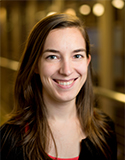 Catherine Grevet, Ph.D. Candidate
Catherine Grevet, Ph.D. Candidate
Social Computing, School of Interactive Computing
Georgia Institute of Technology
Research Area: Being Nice on the Internet: Designing for the Coexistence of Diverse Opinions Online
Exposure to diverse opinions makes us more informed and engages society in a necessary deliberation process. Inwardly focused groups risk tunnel vision and an inability to challenge their own views. Technically, online we can connect to anyone in the world, but social network analyses of blogs and Twitter have shown that we stay connected in groups of like-minded others. There is untapped potential here for online environments to go further towards giving more access to diverse views. I posit that the prevalence of incivility in social media drives a growing divide between people of different opinion. My dissertation aims for an empirical understanding of current practices around engaging with friends of different opinion, and design implications around facilitating civility online. I have studied how people currently manage relationships with friends of different opinion online. Currently, I’m designing and building social media features to create a more welcoming environment for diversity.
Catherine is a Ph.D. candidate in Computer Science, with a focus on Human-Computer Interaction and Social Computing in the School of Interactive Computing at Georgia Tech, advised by Eric Gilbert in the comp.social lab. Her research focuses on designing civil online spaces as a necessary component to maintaining friendships between people of diverse opinions online. She has done internships at Google and Apple. She holds a B.A. in Computer Science from Wellesley College, where she did her undergraduate thesis on personal informatics and sustainability behavior change, and an M.S. in CS/HCI from Georgia Tech.
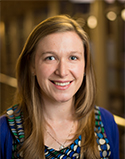 Judy Hoffman, Ph.D. Candidate
Judy Hoffman, Ph.D. Candidate
EECS
UC Berkeley
Research Area: Large scale recognition through adaptation
In recent years, dramatic progress has been made in object recognition, due in large part to the accessibility of increasingly large annotated datasets. However, for many real-world recognition tasks there is no, or very little, available annotated data. Instead of relying on the impractical goal of collecting a large amount of annotated data for every possible scenario, domain adaptation offers techniques to learn models using available large datasets and adapt those models for each new task or setting. Our most recent work focuses on adapting feature representations, learned from deep convolutional neural networks, to perform new tasks. In particular, Large Scale Detection through Adaptation (LSDA) is our recently proposed method that learns to adapt image classifiers into object detectors. This enables the production of strong detector models for categories that have only image level tags, which are prevalent across the web, as opposed to requiring thousands of bounding box annotated images. With this approach, we have been able to scale the standard 200 category detector up to 7K categories while maintaining competitive performance.
Judy Hoffman is a 5th year Ph.D. student, whose research focuses on object recognition, domain adaptation, and deep learning. She is advised by Professor Trevor Darrell in the UC Berkeley Computer Vision lab. She has published papers in the top computer vision conferences (CVPR, ECCV, ICCV), as well as representation learning venues (ICLR). She is currently funded by the NSF-GRFP and was previously funded by the Rosalie M. Stern fellowship. She has served as co-president of WICSE (graduate women in computer science) and as the outreach and diversity coordinator for CSGSA (computer science graduate organization). In addition, she has volunteered in mentoring programs for the last four years, offering one on one advice to undergraduates and first year graduate students.
 Carolyn Schutt Ibsen, Postdoctoral Researcher
Carolyn Schutt Ibsen, Postdoctoral Researcher
Nanoengineering & Bioengineering
UC San Diego
Research Area: Ultrasound-Modulated Fluorescent Contrast Agent for Optical Tumor Characterization
The small size of early stage tumors makes them difficult to detect and treat. Localized light generation within a small tissue volume can yield spatially-resolved chemical information about the tissue microenvironment. This can help differentiate small cancerous lesions from benign masses enabling the detection of smaller, earlier-stage tumors. The detection of this locally-generated light is made difficult by the highly-scattering nature of biological tissue which confounds the spatial information in the signal. In comparison, acoustic ultrasound does not scatter in tissue nearly as much providing high spatial resolution. Combining optical and acoustic imaging modalities presents an avenue for obtaining highcontrast, physiologically-relevant optical information with improved spatial resolution.
This work develops a new technique using fluorescent microbubbles that generate light in the small focal zone of an ultrasound beam by consistently modulating their fluorescence intensity. These first-in-class contrast agent particles were designed with the nano-scale surface characteristics necessary to generate a consistently blinking fluorescent light in response to focused ultrasound. By amplifying these characteristic intensity modulations with a lock-in amplifier, the fluorescence from these locally-activated microbubbles was detected for the first time in an optically-scattering environment and at significant depth. Using a spectral analysis program it was shown that these microbubbles also displayed harmonic oscillations beyond the ultrasound driving frequency which could be used to further improve the signal to noise ratio for detection. This technique could enable sensitive optical imaging with ultrasound-scale millimeter-level spatial resolution, providing an important tool to address the challenge of optical imaging in deep tissue.
Carolyn did her doctoral work in the nanotechnology laboratory of Dr. Sadik Esener at the University of California, San Diego. Her research focused on using light and ultrasound to develop new drug delivery systems and diagnostics for cancer applications. Her work on diagnostics involved the development of a new microbubble-based imaging system that uses ultrasound to modulate the size of a specially-coated microbubble which in turn modulated the microbubble’s fluorescence properties causing it to “blink”. These blinking bubbles can be used to determine the chemical nature of the microenvironments in and around suspected tumor lesions to help differentiate malignant tumors from benign masses. She also developed a drug delivery nanoparticle that is comprised entirely of photocleavable prodrugs of the chemotherapeutic doxorubicin. These prodrug nanoparticles are significantly less toxic than the original drug allowing them to pass through healthy tissue with little side effects. The particles can be converted to active drug when exposed to the correct wavelengths of light which are delivered specifically to the tumor using LED and fiber-optic systems. As a postdoc in the Nanoengineering department at UCSD Carolyn worked on developing a dual fiber-optic system that is capable of both quantifying the amount of light-activatable drug delivery nanoparticles present in tissue as well as being able to activate them. This has important clinical applications in being able to monitor and control drug doses in the tumor. She also has experience working at a startup company that uses nanotechnology to help localize prodrug activation through enzyme-cleavable pathways.
 Mobin Javed, Ph.D. student
Mobin Javed, Ph.D. student
Computer Security
UC Berkeley
Research Area: Detecting Stealthy, Distributed Attacks
The computer security landscape follows an arms race; attackers continuously adapt to bypass the detection and prevention mechanisms deployed by the defenders. One such expected shift is towards stealthy, distributed attacks in which an attacker distributes the work across multiple machines such that the activity from a single machine remains too low to be deemed malicious. This makes detection using traditional approaches, which employ per−host thresholds, impossible. Consequently, the security community lacks an understanding of the extent to which such attacks are prevalent today, let alone a principled method to detect them.
In this work, we tackle this long−standing challenge and present a general methodology for detecting such stealthy, distributed attacks. We apply our approach to the problem of detecting distributed SSH brute−force attacks, which harness a number of systems to try different username/password combinations against a site's SSH login servers, in the hope that one of them will stumble across a working combination. Using our detector, we find dozens of instances of such attacks in an extensive eight−year dataset collected from a site with several thousand users. Many of the attacks −−− some of which last months −−− would be quite difficult to detect individually. While a number of the attacks reflect indiscriminant global probing, we also find attacks that targeted only the local site, as well as occasional attacks that succeeded.
Mobin Javed is a fifth year Ph.D. student in Computer Science at UC Berkeley, advised by Vern Paxson. Prior to moving to Berkeley, she completed her Masters and Bachelors from National University of Sciences and Technology (NUST), Pakistan. Mobin has interned at Microsoft Research and at Impermium, a cyber−security start−up.
Mobin's research focuses on leveraging data science to discover emerging security and privacy threats. She is interested in the analysis of real−world data from large−scale networked systems, geared towards illuminating the activities of adversaries in the evolving Internet landscape. Her major projects include: (i) detection of stealthy and distributed attacks, (ii) characterization of large−scale cloud abuse, (iii) measurement of device−tracking information and browsing−profile leakage, and (iv) measurement of large−scale Internet censorship.
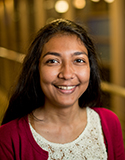 Samira Khan, Postdoctoral Researcher
Samira Khan, Postdoctoral Researcher
ECE
Carnegie Mellon University
Research Area: New System-Level Techniques to Enable Scaling of DRAM Memory
The increasing number of cores and extensive use of data-intensive applications demand high capacity main memories. Scaling of DRAM to smaller technology nodes enabled higher capacity in the same die area for the past few decades. However, as DRAM cells scale down in size, they become significantly less reliable, exhibiting errors in the field. Ensuring reliability with technology scaling is a key challenge for DRAM. Our research focuses on characterizing DRAM memory failures with the goal of developing efficient techniques to ensure reliable memory operation in future technology nodes. Our vision is to enable scaling by detecting and mitigating DRAM failures in the field, during the operation of DRAM in the system. We refer to system-level error detection as online profiling. In an online profiling system the memory controller is responsible for detecting and mitigating failures while the system is running. Such a system reduces manufacturing cost and increases yield by enabling the manufacturers to ship DRAM chips without fully ensuring that all cells operate correctly.
Samira Khan is a Post Doctoral Researcher at CMU, working with Professor Onur Mutlu. She is also associated with Intel Labs, Hillsboro. Her research focuses on improving the performance, efficiency, and reliability of the memory hierarchy of modern processors. She received her Ph.D. from the Department of Computer Science in the University of Texas at San Antonio.
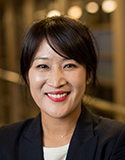 Sunyoung Kim, Postdoctoral Fellow
Sunyoung Kim, Postdoctoral Fellow
Center for Research on Computation and Society
Harvard University
Research Area: Democratizing mobile technology in support of volunteer activities in data collection
Mobile technology is advancing our ability to connect and share information in ways that were not possible before. It makes an ideal platform for people to participate in volunteer activities for data collection, as mobile technology can transform simple data sharing in our daily lives into meaningful participation in solving real-world problems. Volunteer participation is a powerful method for collecting data, as the availability of so many volunteers allows the collection of a large amount of data that could not be obtained with the use of professionals only. Also, it enables the collection of data over spatial and temporal scales at reduced cost and time. Despite its potential, the actual usage rate of mobile technology in volunteer activities has been low, and our understanding of why the domain of volunteering has a lower rate of mobile technology adoption remains weak. Furthermore, how mobile technology is perceived, evaluated, adopted, or declined for adoption for data collection in volunteer activities has yet to be fully determined. This work conducts a series of investigations into current practices, challenges, and opportunities associated with mobile technology use in volunteer activities from the perspective of the community organizers. From these investigations, I developed an authoring system, SENSR, to help create mobile data collection solutions, with the intention of democratizing the capabilities of mobile technology towards digital volunteering efforts. Finally, through a longitudinal field deployment, this thesis advances our understanding of volunteerism themed mobile applications by first studying the underutilization of such mobile technology in situ and later developing a series of potential opportunities for designing more effective mobile volunteer activity technologies.
Sunyoung Kim is a CRCS Postdoctoral Fellow at Harvard University. She earned her Ph.D. degree in HCI from Carnegie Mellon University in 2014 under Eric Paulos and Jennifer Mankoff, and her M.S. degree in HCI from Georgia Institute of Technology in 2008 under Gregory Abowd.
 Danai Koutra, Ph.D. Candidate
Danai Koutra, Ph.D. Candidate
Computer Science Department
Carnegie Mellon University
Research Area: Large Graph Mining and Sense-making
Given a large graph, like Facebook or Gmail, what can we say about its structure? Which are the most important structures in the graph? Are there many cliques, stars and chains or are there more complex structures? What do the structures reveal? Are there anomalies? How does the graph change over time? My thesis focuses on developing fast algorithms and models that promote the understanding of large graphs at different granularities: node and graph level. For this purpose I go after two directions: similarity analysis, and pattern mining and modeling. For similarity analysis, I mainly concentrate on finding node affinities and roles, developing graph similarity approaches when the node correspondence is known or unknown, and using graph alignment to reveal similarities between nodes across different networks. For pattern mining, the goal is to provide the domain expert with a succinct summary of one or more graphs with billion nodes and edges, and spotlight the "important" and "interesting" (anomalous) graph patterns. For that reason, I model features in a variety of graphs, and also propose a graph summarization approach that unveils semantically interesting structures. Applications come from the domain of neuroscience, where I study brain connectivity graphs, as well as static or time-evolving social and collaboration networks (e.g., Twitter, Facebook, DBLP, IMDB, Enron, YahooWeb).
Danai Koutra is a final-year Ph.D. candidate in the Computer Science Department at Carnegie Mellon University. Her research interests include large-scale graph mining, graph similarity and matching, graph summarization, and anomaly detection. Danai's research has been applied mainly to social, collaboration and web networks, as well as brain connectivity graphs. She holds one ``rate-1'' patent and has six (pending) patents on bipartite graph alignment. Danai has multiple papers in top data mining conferences, including 2 award-winning papers, and her work has been covered by the popular press, such as the MIT Technology Review. She has worked at IBM Hawthorne, Microsoft Research Redmond, and Technicolor Palo Alto/Los Altos. She earned her M.S. in Computer Science from CMU in 2013 and her diploma in Electrical and Computer Engineering at the National Technical University of Athens in 2010.
 Maithilee Kunda, Research Scientist
Maithilee Kunda, Research Scientist
School of Interactive Computing
Georgia Institute of Technology
Research Area: Visual Problem Solving in Humans and Artificial Agents
A significant amount of computational research into intelligent problem solving has focused on the use of verbal or propositional representations of knowledge. However, evidence from many different disciplines suggests that humans can, and do, solve problems using numerous distinct types of mental representations, including visual ones. My research investigates visual problem solving in three related domains: visual category learning during typical infant development, atypical visual cognitive processing in individuals diagnosed with autism, and the role of visual strategies in psychometrics and cognitive assessment. For each of these domains, I identify the need for information processing accounts that incorporate visual representations and develop new AI techniques to fulfill this need. These new techniques not only expand the capabilities of current AI systems but also promote a deeper scientific understanding of human intelligence, especially in the context of uncovering links between brain and behavior in atypical development.
Maithilee Kunda is a research scientist in the School of Interactive Computing at Georgia Tech. Her work in artificial intelligence (AI) and cognitive science seeks to understand what role visual representations of knowledge play in learning and intelligent behavior. In particular, her research aims to leverage findings from studies of human intelligence to build increasingly more intelligent machines that approach human-level performance on a variety of tasks, as well as to use innovations in technology and computational modeling to advance basic research into cognition and to create positive, real-world impact in the fields of education and neuropsychological assessment. She earned her B.S. in Mathematics with Computer Science from the Massachusetts Institute of Technology in 2006 and her Ph.D. in Computer Science from the Georgia Institute of Technology in 2013. She has received research fellowships from the National Science Foundation, the Department of Defense, and the Department of Energy, and, in 2010, was selected as a Foley Scholar by the Georgia Tech GVU Center and as an Anita Borg Memorial Scholar by Google.
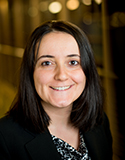 Duygu Kuzum, Postdoctoral Fellow
Duygu Kuzum, Postdoctoral Fellow
Bioengineering
University of Pennsylvania
Research Area: Electronics for brain-inspired computing and probing brain circuits
The efficiency of today’s information processors has been dominated by transistor scaling based on Moore’s Law. However, in the nano-era, device scaling started to face significant barriers to achieving historical performance gains. Besides the scaling limits, the conventional computing paradigm based on binary logic and Von Neumann architecture have become increasingly inefficient as the complexity of computation have increased. Brain-inspired architectures and reconfigurable-adaptive systems are emerging research fields aiming to go beyond capabilities of digital logic and eventually to reach brain-level efficiency. In this first part of my talk, I will present a novel electronic device for brain-inspired computing, mimicking functionalities of biological synapses in the brain. I will discuss several aspects of brain computation including energy efficiency, robustness and parallelism and compare with state-of-the-art super computers. I will explain how we can use synaptic devices in brain-inspired architectures to demonstrate learning and robustness in hardware. Then I will discuss how synaptic devices can help understanding brain computation. In the second part of my talk, I will introduce a new flexible transparent neural probe made of graphene. I will discuss electrochemical characteristics and noise performance of transparent probes in in vivo recordings. Then, I will explain how the transparent probes enable simultaneous calcium imaging and electrophysiology in hippocampal slices to study circuit dynamics with high spatio-temporal resolution.
Duygu Kuzum applies innovations in nanoelectronics to develop new technologies, which will help us better understand circuit-level computation in the brain, and develops novel tools to probe neural circuits with high precision. She developed nanoelectronic synaptic devices emulating the synaptic computation and plasticity in the human brain. This technology could lead to portable and energy-efficient computers that can learn and process information in real time similar to the human brain. She interfaces nanoelectronic synapses with biological neurons to build hybrid biocomputation platforms and more brain-compatible neural prosthetics. She is the author or coauthor of over 40 journal and conference papers. Her work on nanoelectronic devices was featured on the cover of Nano Letters, highlighted in Nature and covered by several media outlets (New Scientist, Stanford News Report, Nanowerk, EE Times). She has been a recipient of a number of awards, including a Texas Instruments Fellowship and an Intel Foundation Fellowship, a PopTech Science and Public Leaders Fellowship (2013) Award,a Penn Neuroscience Pilot Innovative Research Award (2014), a TASSA (Turkish-American Scientists and Scholars) Young Investigator Award (2014), and an Innovators under 35 (TR35) by MIT Technology Review (2014).
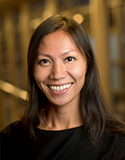 Loan T. Le, Ph.D. Candidate
Loan T. Le, Ph.D. Candidate
Department of Electrical Engineering, Mid-IR Photonics Group
Princeton University
Research Area: Ultra-Broad Gain Quantum Cascade Lasers
All diseases, without exception, are caused by biochemical changes in tissues and organs. They all start from just a single cell. By the time symptoms appear and doctors are able to diagnose the disease, it has often progressed too far to be cured. If doctors were able to detect these changes as soon as they occurred, the disease could be diagnosed and potentially cured. However, detecting one bad cell among a sea of good cells is challenging. Mid-Infrared (mid-IR) spectroscopy is an extremely sensitive technique that enables non-invasive detection and discrimination of molecules in concentrations as small as one part per trillion. Hence, the mid-IR is also known as the molecular fingerprinting region. Today, to fully utilize the analytical potential of the mid-IR, one would have to rely on synchrotron radiation for the unmatched combination of power, brightness, spectral range, and beam quality. My research focuses on the design of broadly tunable, high performance quantum cascade lasers, a technology that has potential to rival the synchrotron source. Since their invention more than two decades ago, QC lasers have become the much sought after mid-IR source for many practical applications due to their compactness, robustness, and high performance (high output power, tunability, and wavelength tailorability by means of band-structure engineering). However, there are spectroscopic applications, particularly in medicine and biology, where absorption features of molecules are broad, and hence the wide wavelength tunability of a laser source is desired. In our approach, we attempt to understand the fundamental physical limits of spectral width of QC lasers, and we aim to engineer a single stack gain medium approaching this limit. We propose a design that combines two relatively recent and distinct concepts of bandstructure design in QC lasers: ultra-strong coupling of the injector ground states to the upper laser state and an ultra-short injector region. Our design pushes the limits of the ultra-strong coupling concept by utilizing an ultra-thin injection barrier to achieve multiple strongly coupled upper laser states that transition to multiple lower laser states while compensating for the performance tradeoff of broad-gain designs with an ultra-short injector region. Experimentally, we have confirmed that this design produces the widest QC gain spectrum spanning 4-14μm, a region of chemical and bio-molecular importance, with high power emission and room temperature performance. Successful development of this technology promises delivery of affordable light sources for mid-IR spectroscopy to every research lab and hospital in the world. Imagine a synchrotron source on the desktop.
Loan was born in Ben Tre, a small village in Vietnam and immigrated to America with her family at the age of 4. She grew up in the Bronx and won a New York Times scholarship to pursue her undergraduate degree at Princeton University. Her passion was for journalism and international affairs, but her curious and inquisitive nature led her on an unexpected path. In her third year at Princeton, Loan switched from the humanities into engineering. It is the ability to probe into an unknown realm of nature and uncover something unique and potentially useful to mankind that attracts Loan to science. Loan graduated with a BSE in Mechanical and Aerospace Engineering and went on to join a start-up solar energy company for two years. After that, she became a lab manager in Professor Claire Gmachl’s mid-IR Photonics group at Princeton University, where she was introduced to the emerging field of Quantum Cascade lasers, which soon turned into a Ph.D. career for Loan. She is preparing several papers for publication and expects to complete her dissertation in less than a year. The future is exciting, and Loan sees herself pursuing an academic career in the STEM field. Her scientific interests are at the confluence of physics, life sciences, and nanofabrication.
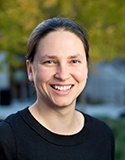 Frauke Oldewurtel, Postdoctoral Researcher
Frauke Oldewurtel, Postdoctoral Researcher
EECS
UC Berkeley
Research Area: Control under uncertainty - Adaptive stochastic MPC and grid frequency control with buildings
The first part of my research deals with Stochastic Model Predictive Control (SMPC) for discrete-time linear systems subject to additive disturbances with chance constraints on the states and hard constraints on the inputs. Current chance constrained MPC methods—based on analytic reformulations or on sampling approaches—tend to be conservative, partly because they fail to exploit the predefined violation level in closed-loop. For many practical applications, this conservatism can lead to a loss in performance. We propose an adaptive SMPC scheme that starts with a standard conservative chance constrained formulation and then on-line adapts the formulation of constraints, based on the empirical violation level. Using martingale theory we establish guarantees of convergence to the desired level of constraint violation in closed-loop for a special class of linear systems. The developed methodology is demonstrated with an illustrative example. In the second part, grid frequency control with buildings is considered. The increasing penetration of fluctuating renewable energy sources leads to more demand for frequency control reserves. Frequency control reserves are traditionally provided by generators in order to ensure that supply-demand mismatches in the electricity grid can be mitigated at all times. It is commonly argued that more demand-side participation for reserve provision would be desirable. In this work we focus on frequency control reserve provision by heating, ventilation, and air conditioning systems of an office building aggregation.
Frauke Oldewurtel received the Master of Science in Electrical and Computer Engineering from the Georgia Institute of Technology in 2004 and her Diploma in Industrial Engineering from the Technical University of Braunschweig, Germany in 2006. In 2011, she received her Ph.D. at the Automatic Control Laboratory at ETH Zurich, Switzerland. Afterwards, she spent two years as a PostDoc at the Power Systems Laboratory of ETH Zurich, and since 2014, she has been a Marie Curie Fellow at UC Berkeley. Her main interests are in control of uncertain systems, model predictive control, building climate control, and electricity grids.
 Shruti Patil, Postdoctoral Scholar
Shruti Patil, Postdoctoral Scholar
Computer Science and Engineering
University of California at San Diego
Research Area: Computing Circuits with Spintronic Devices
Emerging technologies hold the potential to enable computing with exponential speed-ups or theoretical lower bounds on power. However, the challenges of harnessing these abilities in practical systems are myriad and unique. For instance, Spintronics uses the electron spin to define magnetoresistance as a new state-variable for processing and storing data. This state variable can be switched near thermodynamic limits of power dissipation, but to use this potential, we need fundamentally novel computing circuit designs that can allow complex operations to be performed with minimal overheads from driving circuits. This work investigates design techniques that can enable the basic properties of composability, input-output signal compatibility and scalability in circuits that use Spintronics-based devices. Leveraging these techniques, we show the design of larger spintronic logic circuits such as an ALU and a Spintronic logic-in-memory unit using spin-based devices of Magnetic Tunnel Junctions.
Shruti Patil is a Postdoctoral Scholar at University of California at San Diego. She received the Ph.D. degree in Electrical Engineering from University of Minnesota in 2011. Her research focused on designing computing circuits with the emerging technologies of Spintronics and NEMS. She worked as a Research Scientist at Intel Labs in Santa Clara in 2012, and then joined Princeton University as Postdoctoral Associate to work on architectures for Quantum Computing. Currently at UCSD, she works on addressing power challenges in mobile platforms using emerging technologies.
 Tamara Peyton, Ph.D. Candidate
Tamara Peyton, Ph.D. Candidate
Information Sciences and Technology
Pennsylvania State University
Research Area: Facilitating wellness in times of strain: Sociotechnical design for transition life events
Individuals frequently turn to mobile technologies and social media for support in managing their health during life transition health events, such as being pregnant with a first child. These health events present a potential teachable moment for health and wellness behavior, because individuals are most often motivated to make changes when an event makes visible the aspects of their lifestyle, their coping behaviors and the social support networks that impact their overall health and wellness. Existing design and development paradigms draw on health behavior models that focus on health ‘problems’ and are geared toward managing, minimizing or eliminating risk behaviors. In transition life events, people do not necessarily see the event as part of a risk scenario, and therefore often reject guidelines on how to manage their health during the transition period. This rejection necessitates an alteration in mobile health design paradigms, away from a focus on risk reduction and towards a focus on wellness potential. How can a technological system incorporate appropriate handles for encouraging and facilitating personal collaborative information seeking and social support for health events in bounded transition periods, such as pregnancy? What new transition wellness support opportunities might be enabled if the positive transition concepts of possibility, resiliency and adaptability are highlighted in technology design, rather than the negative concepts of risk, danger and ruin? Addressing these two research questions, by drawing on data and analysis from a mixed methods qualitative study, my project will specify a positive socio-ecological development model to guide the design of mobile and web technologies to support transitional life events, and to encourage positive wellness habits. As a case study, the project will collaborate with lower-income women in pregnancy, with the goal of co-designing and developing a prototype of a mobile app for pregnancy wellness support.
Tamara Peyton is a Ph.D. candidate in the Health Information Technologies Lab (HInT-L), in the College of Information Sciences and Technology, at The Pennsylvania State University. She draws on a social sciences background and her former career as an IT professional and UX designer for internet and groupware systems. Tamara was awarded an AT&T Graduate Research Fellowship for her dissertation research, which considers the health impact of mobile technology interventions on life transition challenges and which specifies alterations to the design paradigms these events present to technology builders. She has published and presented work about mobile health development for pregnancy, about designing for adolescents and young adults, and about the impacts of large scale social MMO and ARG game design on sociality, leadership and expertise.
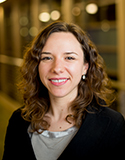 Laura Popa, Ph.D Candidate
Laura Popa, Ph.D Candidate
Physics
MIT
Research Area: GaN RF MEMS Resonators in MMIC Technology
As a wide band-gap semiconductor, with large breakdown fields and saturation velocities, gallium nitride (GaN) has been increasingly used in high-power, high-frequency electronics and monolithic microwave integrated circuits (MMICs). At the same time, GaN has excellent electromechanical properties, such as high acoustic velocities and low elastic losses. Together with a strong piezoelectric coupling (kT2 of 2%), these qualities make GaN ideal for RF MEMS resonators. Hence, this technology offers a platform for the seamless integration of high performance RF MEMS resonators with high power, high frequency electronics. Monolithic integration of MEMS resonators with ICs would lead to reduced parasitics and matching constraints, enabling high-purity clocks and frequency-selective filters for signal processing and high-frequency wireless communications. In this presentation I will discuss the resonator design considerations that must be taken into account in a monolithically integrated solution, showing devices that achieve the highest frequency-quality factor product in GaN resonators (9.5×1012). I will also highlight several transduction mechanisms enabled by this technology, such as the ability to use the 2D electron gas (2DEG) channel of High Electron Mobility Transistors (HEMTs) as an electrode for transduction. This enables a unique out-of-line switching capability which allowed us to demonstrate the first DC switchable piezoelectric resonator. Finally, we discuss the benefits of using active HEMT sensing of the mechanical signal when scaling to GHz frequencies, which enabled the highest frequency lithographically defined resonance reported to date in GaN (3. 5 GHz). Finally, extending the functionality of our GaN resonators to include bulk resonant sensors can lead to extraordinary breakthroughs in terms of sensitivity, bias stability and shock reliability. I will discuss ways in which we can use the strain dependent 2DEG and HEMT sensing in a variety of physical sensors, especially inertial sensors. This can increase transduction efficiency, and lead to higher displacements, higher signal-to-noise ratio. Additionally, active pick-off using HEMT sensing provides an increase in signal-to-noise ratio, allowing for miniaturization and, implicitly higher shock reliability.
Laura Popa completed her undergraduate work at Bryn Mawr College in 2009 and is currently a Ph.D. candidate in the Physics department at MIT. As a graduate student, she became interested in device physics and MEMS, and joined the HybridMEMS group. Her research focuses on piezoelectric Gallium Nitride RF MEMS resonators for filter and timing applications in wireless communications.
 Gireeja Ranade, Ph.D. Candidate
Gireeja Ranade, Ph.D. Candidate
EECS
UC Berkeley
Research Area: Information flows in control systems
Machine-to-machine communication has become very relevant today with the development of the Internet of Things. We envision a future with efficient, adaptable machines (e.g. self-driving cars, self-organizing networks for manufacturing) that naturally interact with their surroundings to perform high-accuracy tasks at high-speed. Faster processors, more bandwidth and Moore's law will move us closer to this vision, but they cannot get us all the way there.
Communication and control co-design is necessary to hit the operating points we are aiming for. For this, my research develops models to understand the information bottlenecks that manifest in high-performance control systems. Such systems can involve uncertain parameters that may be difficult to track at the time scale necessary for control actions. This parameter uncertainty manifests as a multiplicative noise, which acts as a 'scrambling bottleneck' for the information flow in systems. Our models illustrate why this happens and show how the traditional separation paradigm of 'estimate-then-control' might fail for these systems.
Parameter uncertainty can be further characterized by looking at the performance improvement that comes when this uncertainty is reduced through side information. To explore this we define a notion of the 'value of information' in control. We show an example where future network state information is valuable for system control even though it would be useless for pure communication. These theoretical insights can influence control and communication protocol design, since the MAC protocol generally knows in advance when it might drop or delay a packet.
A second branch of my research develops wireless communication protocols for low-latency high-reliability industrial control. High-performance in this regime is essential for the IoT vision of the future.
Gireeja Ranade is a Ph.D. candidate in the EECS department at UC Berkeley working with Prof. Anant Sahai. She received an S.B. in EECS from MIT in 2007 and an M.S. in EECS from UC Berkeley in 2009. Her research includes work on cardiovascular monitoring technology, brain-machine interfaces, information theory, control theory and crowdsourcing.
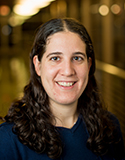 Noga Ron-Zewi, Postdoctoral Fellow
Noga Ron-Zewi, Postdoctoral Fellow
School of Mathematics
Institute for Advanced Study, Princeton
Research Area: Additive Combinatorics Methods in Computational Complexity
My research interests lie in theoretical computer science and its interactions with modern research directions in discrete mathematics. A unifying theme in my work so far has been the use of methods and techniques from the mathematical field of additive combinatorics for making progress on open problems in the area of computational complexity, most notably in the sub-fields of pseudorandomness, communication complexity and local decoding.
l am currently a member of the Institute for Advanced Study at Princeton, hosted by Prof. Avi Wigderson. I received my Ph.D. from the Department of Computer Science at the Technion in 2014, under the supervision of Prof. Eli Ben-Sasson. My research interests lie in theoretical computer science and its interactions with modern research directions in discrete mathematics. Specifically, my Ph.D. research focused on applying methods and techniques from the mathematical field of additive combinatorics for making progress on open problems in the area of computational complexity. I am also a Rothschild Fellow, received a scholarship for the advancement of women in science from the Israel Ministry of Science of Technology and was selected as Google’s Anita Borg Memorial Scholarship finalist.
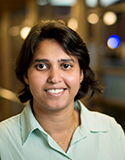 Tania Roy, Postdoctoral Scholar
Tania Roy, Postdoctoral Scholar
EECS
UC Berkekley
Research Area: Devices for low power electronics using two-dimensional materials
Two-dimensional materials provide pristine surfaces and interfaces, which are free of traps resulting from unpassivated dangling bonds. As a result, the carrier mobilities in these materials do not degrade at high electric fields, due to the absence of surface roughness scattering. These 2D materials also provide sharp band edges, facilitating the realization of low-power, low-voltage, steep transistors. 2D-to-2D tunneling can be used to build tunnel transistors with two 2D materials, while controlling their bandgap and their band alignments.
Tania Roy obtained her B.E. (Hons.) degree in Electrical and Electronics Engineering, from Birla Institute of Technology and Science, Pilani, India in 2006. She completed her Master’s and Ph.D. degrees in Electrical Engineering from Vanderbilt University, in 2008 and 2011, respectively. Her Ph.D. research focused on reliability analysis of GaN/AlGaN high electron mobility transistors. She worked on graphene tunnel transistors for low power electronics as a Postdoctoral Fellow under Prof. Eric Vogel at Georgia Institute of Technology from 2011 to 2013. She is currently working on steep transistors for low power electronics, using two-dimensional materials, as a Postdoctoral Scholar under Prof Ali Javey at University of California, Berkeley. In 2014, she was instrumental in realizing the world’s first all-two-dimensional transistor.
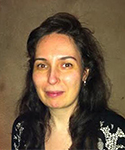 Alla Rozovskaya, Postdoctoral Research Scientist
Alla Rozovskaya, Postdoctoral Research Scientist
Center for Computational Learning Systems
Columbia University
Research Area: Automated Methods for Text Correction
The task of text correction has been of interest to researchers in Natural Language Processing and Machine Learning for many years. Over the last several decades, as people rely increasingly on computers for writing and editing, the need for automatic systems that can identify and correct errors not typically targeted by standard text correction tools has grown. In this talk, I will present our research on developing computational models for correcting writing mistakes made by English as a Second Language (ESL) learners. Using the observation that mistakes made by ESL writers are systematic, we develop models that utilize knowledge about error regularities with minimal annotation costs. Our approach differs from earlier ones that either built models that had no knowledge about error regularities or required a lot of annotated data, and significantly outperforms both of these methods.
Alla Rozovskaya is a Postdoctoral Research Scientist at the Center for Computational Learning Systems at Columbia University. She received her Ph.D. in Computational Linguistics and an M.S degree in Computer Science from the University of Illinois at Urbana-Champaign. Her research interests are Natural Language Processing, Computational Linguistics, and Machine Learning. Her thesis focused on developing automated methods for text correction. The models that she developed won international competitions in text correction.
 Yakun Sophia Shao, Ph.D. Candidate
Yakun Sophia Shao, Ph.D. Candidate
Computer Science
Harvard University
Research Area: Modeling and Design for Customized Architectures
Computing systems ranging from wireless sensor nodes to high-performance servers are designed for hard power envelopes due to battery and thermal constraints. Low-power design techniques targeting general-purpose CPUs have largely been exhausted, and the next frontier of energy-efficient design will focus on specialization due to the potential for 10-100X energy efficiency gains. In this context, the design and integration of a large number of specialized accelerators is emerging as an important architectural challenge for the next general computing platform. My approach to this challenge is to provide research infrastructure across layers of the accelerator design flow - from hardware implementations, architecture-level simulation, workload characterization and benchmarks - to facilitate the design and integration of specialized accelerators. My dissertation proposes Aladdin, a pre-RTL, power-performance simulator for hardware accelerators that can quickly explore the design space of accelerators and model the interaction between accelerators and other components in a heterogeneous system. Aladdin is one of the first efforts to model the behavior of accelerators at the architecture level. In addition to Aladdin, I also developed the WIICA workload characterization framework to assist accelerator designers in quickly identifying opportunities for acceleration, and an instruction-level energy model for Intel’s Xeon Phi co-processor to provide software programmers an easy way to estimate the energy cost of programs.
Yakun Sophia Shao is a Ph.D. candidate in Computer Science in the School of Engineering and Applied Sciences, Harvard University, working with Professor David Brooks. Her primary research interests lie in the general area of computer architecture, with particular emphasis on modeling and design for heterogeneous architectures. She received her B.S. degree in Electrical Engineering from Zhejiang University, China and her M.A. degree in Computer Science from Harvard University. Her previous experience includes internships in the Parallel Computing Lab at Intel, Santa Clara, CA and the Systems Technology and Architecture Department at IBM’s T.J. Watson Research Center in Yorktown Heights, NY.
 Justine Sherry, Ph.D. Candidate
Justine Sherry, Ph.D. Candidate
Networked Systems Lab
UC Berkeley
Research Area: Record and Replay Recovery for Middleboxes
Middleboxes -- such as proxies, WAN Optimizers, and intrusion detection systems (IDSes) -- are often stateful, keeping logs of active connections, port mappings, packet caches, and other data about users, connections, and services. When middleboxes fail, lost state can lead to reset connections, lost logs, and security concerns. Hence, like other systems, it is desirable to design middleboxes for high availability, with automatic failover when a device suffers a hardware or electrical failure; such failover should ensure that no state is lost. However, middleboxes are a challenging target for HA, first because their state changes rapidly (sometimes even updating per-packet) and second, because latency expectations for packet service are typically under a millisecond to avoid inflating flow completion times. To this end, we present FTMB, a record-and replay approach to middlebox failover which records middlebox state without imposing a heavy latency penalty on traffic.
Justine Sherry is a Ph.D. candidate at UC Berkeley. Her interests are in computer networking; she has published on middleboxes, measurement, Internet architecture, and congestion control. Justine received her M.S. from UC Berkeley in 2012, and her B.S./B.A. from the University of Washington in 2010. She is an NSF Graduate Research Fellow and is always on the lookout for a great cappuccino.
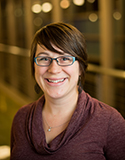 Sarah Swisher, Ph.D. Candidate
Sarah Swisher, Ph.D. Candidate
EECS - Printed Electronics Group
UC Berkeley
Research Area: Applications of Novel Solution-Processed Nanomaterial Systems
Printed electronics have received a great deal of attention in recent years for applications ranging from flexible displays to smart consumer packaging to biomedical devices. In this talk, I will begin by discussing our work on the development of solution-processed electronic materials, with emphasis on transparent metal-oxide semiconductors. These materials (i.e. In2O3, SnO2, ZnO, and combinations thereof) are promising candidates for transparent electronics in next generation displays; such materials are expected to enable the realization of transparent pixel transistors that do not block light, allowing brighter displays with higher aperture ratios. In addition to superior properties for displays, many of these materials are biocompatible, making them an excellent choice for integration into biomedical devices. As an example, I will discuss our recent progress on the development of a “smart bandage” – a flexible electronic device for detecting and monitoring tissue wounds in vivo.
Sarah Swisher received her BS in Electrical Engineering from the University of Nebraska-Lincoln in 2004. Upon graduation, Sarah spent several years as the lead electrical design engineer for a series of GPS-enabled bicycle computers at Garmin. She received her MS in Electrical Engineering from the University of California, Berkeley in 2012, and will receive her PhD in the same in 2014 under the guidance of Prof. Vivek Subramanian. Her research has focused on the synthesis, characterization, and applications of solution-processed electronic materials. Sarah was recognized at UNL with the College of Engineering and Technology Outstanding Achievement Award and the Outstanding Senior Award in Electrical Engineering, and she received the EECS Chair’s Excellence Award from UC Berkeley. Sarah has been awarded the National Science Foundation Graduate Research Fellowship, the UC Berkeley Graduate Division Mentored Research Fellowship, and the Intel Foundation Noyce Memorial Fellowship in Microelectronics.
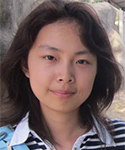 Lele Wang, Ph.D. Candidate
Lele Wang, Ph.D. Candidate
ECE
UC San Diego
Research Area: Channel Coding Techniques for Wireless Networks
Despite the development of coding theory in the past 60 years, there is still a huge gap between the performance of the implementable coding techniques and the information theoretic guarantee, especially in the wireless networks involving multiple senders and receivers. My research aims to bring the conceptual coding schemes in network information theory closer to practice, that is, to develop low-complexity coding techniques with theoretical performance guarantees, such as high rates, small error probability, and low delay.
One crucial challenge is robust channel coding against fading and channel uncertainty. That is, a single code design should perform well in multiple different channels. We have developed low-complexity universal polar codes that resolves an open problem of achieving the optimal rate in compound channel. In addition to providing robustness to point-to-point channel coding, this technique has many potential applications in wireless networks whenever two or more receivers are involved in communication, such as broadcast channels, interference channels, relay channels, among others.
Another crucial challenge is to implement multiuser sequence detection with low complexity in networks with interference. That is to simultaneously exploit the digital structures of multiple signals arrived at the same receiver. First, we have developed a low-complexity polar coding technique that achieves the performance of multiuser sequence detection. Then we have extended it to a random coding scheme that achieves the same performance while only utilizing point-to-point techniques such as superposition coding and single-user detection. This method allows us to leverage good existing codes, such as turbo and LDPC codes, to approach the best known theoretical performance and also serves as an important building block for larger wireless networks.
Lele Wang participated the Academic Talent Program in Tsinghua University, Beijing, China. After receiving the B.E. degree in Electrical Engineering, she has been pursuing the Ph.D. degree in Communication Theory and Systems at UCSD. Her research focus is on information, coding, and communication theory. She is a recipient of the 2013 UCSD Shannon Memorial Fellowship and the 2013-2014 Qualcomm Innovation Fellowship.
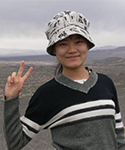 Zhiying Wang, Postdoc
Zhiying Wang, Postdoc
Electrical Engineering
Stanford University
Research Area: Coding for information storage
Zhiying Wang's research bridges information theory and applications in genomic data and data storage. In the past 10 years, genomic data has been generated at a speed much faster than Moore’s Law. As a result, it is necessary to develop efficient tools to store such data for medical treatment and biological research. Her research on compression of genomic data is a step towards this goal, and the work was able to compress some types of genomic data by two orders of magnitude. In addition, there has been an enormous interest in recent times in understanding the role of coding in data storage systems. Dr. Wang is particularly interested in coding problems that balance error-correction ability, communication and storage cost, and data consistency. Her research in this area includes data representation in flash memory, repair-efficient codes for distributed storage, and multi-version codes for information updates in the cloud.
Zhiying Wang is a postdoc at Stanford University. She received her Ph.D. and M. Sc. degrees in Electrical Engineering from California Institute of Technology in 2009 and 2013, and her B.Sc. degree in Information Electronics and Engineering from Tsinghua University, China, in 2007. Her research interests include information theory, theoretical and applied aspects of coding for storage devices, as well as compression for genomic data. She is the recipient of an NSF Center for Science of Information Postdoctoral Research Fellowship in 2013.
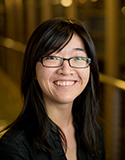 Amy Wu, Ph.D. Candidiate
Amy Wu, Ph.D. Candidiate
Electrical Engineering
Princeton University
Research topic: Cancer progression and emergence of chemotherapy resistance in complex microenvironments
A tumor is a complex system involving adaptive cellular response to a heterogeneous microenvironment, and nonlinear interactions among various types of cells. The fundamental question I addressed in my thesis is how cancer cells ultimately acquire chemotherapy resistance from the perspective of environmental heterogeneity, genomic heterogeneity, and population dynamics. Within a tumor, a complex fitness landscape of cells is established by non-uniform distributions of nutrients, oxygen, and drugs (during chemotherapeutic treatment). Therefore, I designed various chemotherapy gradient devices to mimic a tumor microecology for the assessment of multi-day spatio-temporal dynamics of mammalian cancer cells. Cancer resistance emerged within two weeks in such a microecology. We then performed next-generation sequencing analyses of the rapidly emerged resistant cancer against non-resistant cancer which indicated that gene mutations and expressions play exclusive but equally important roles in resistance. Furthermore, we probed the population dynamics of cancer versus non-cancer cells in the microecology. Considering the migration of the cells, fitness affected by chemotherapy gradients, and fitness affected by population ratios, we successfully predict future densities of cancer and non-cancer cells using a spatially coupled model inspired by evolutionary game theory. In order to study the complexity of cancer and therapy resistance, my approaches include microfluidics experiments, next-generation sequencing analyses, and theoretical modeling. This work contributes to the field of cancer evolution and rapid drug screening by focusing on the reconstruction of heterogeneous tumor microenvironments to study cancer genomes and interactions among various cells.
Amy Wu is a Ph.D. candidate at Princeton University in the Department of Electrical Engineering in the laboratory of Prof. James Sturm and Prof. Robert Austin and working in the fields of microfluidics and quantitative biology. Her thesis work explores the emergence of cancer resistance to chemotherapy from the perspectives of microenvironmental and genomic heterogeneity. Her proposal of exploring “how cancer cells may accept DNA from neighboring cells to construct a more heterogeneous genome” received the Young Investigator Award from the Physical Science Oncology Center program of the National Cancer Institute in 2013. She received a B.S. in Physics and a B.S.with honors in Atmospheric Sciences in 2007, and an M.S. in Electronics Engineering in 2009, all from National Taiwan University.
 He Yi, Ph.D. Candidate
He Yi, Ph.D. Candidate
Electrical Engineering
Stanford
Research Area: Sub-14 nm IC contact/vias patterning using block copolymer directed self-assembly (DSA)
Due to the continuous scaling of semiconductor devices, traditional, conventional lithography is facing increasing challenges. Among all potential alternative patterning approaches, Directed Self-Assembly (DSA) of block copolymers (BCP) has attracted significant interest and attention with low cost and sub-20 nm process. To date, tremendous progress has been made in achieving and controlling periodic DSA patterns over large areas. However, realizing that most challenging IC layout patterns are irregular and that patterning them does not require any long range order, we adopted small topographical templates to flexibly generate and control aperiodic DSA patterns. For the first time, we have illustrated a design strategy that links guiding template designs with design rules and polymer properties. Examples of contact hole patterning for 14 nm, 10 nm, and 7 nm node standard cell libraries using DSA have been demonstrated experimentally.
He Yi is currently a 5th year graduate student in the Electrical Engineering Department at Stanford University advised by Professor H.-S. Philip Wong. She completed her undergraduate study in the Physics Department of Peking University (Beijing, China). Her research focuses on the application of block copolymer directed self-assembly as the next generation lithography, specifically in the patterning of contact holes in integrated circuits.
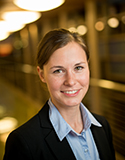 Melanie Zeilinger, Postdoctoral Researcher
Melanie Zeilinger, Postdoctoral Researcher
EECS
UC Berkeley
Research Area: Distributed and learning-based control for high performance in safety-critical systems
When safety is a crucial requirement, control systems are traditionally designed to act in isolated, clearly specified environments, or to be conservative against the unknown. The overarching goal of my research program is to enable high performance control with safety guarantees in varying, uncertain environments, which are potentially large-scale, composed of numerous interconnected subsystems, and involve human interaction. My research addresses this challenging problem by developing novel control paradigms in two main research directions.
The first research area addresses the control of large-scale networks using distributed computing platforms, a key challenge for tackling a range of emerging control problems in important application areas such as power or transportation systems. Model Predictive Control (MPC) offers a promising tool in this context, being a high performance technique for the control of constrained systems. While the theory of MPC in its traditional application areas is well established, the use of predictive control for systems with inherent limitations on computation and communication that may additionally be subject to system and topology changes during closed-loop control is a current research area that has received increasing attention in the last few years. We have proposed a new approach for distributed MPC with reduced conservatism that is based on distributed stability and invariance concepts as well as a new distributed optimization method for its high-speed implementation. My current research focuses on plug and play techniques, allowing distributed controllers to be adapted to network changes on the fly, and on distributed control for power systems, providing integrated optimal control of personal loads and storage capacities with grid stability control.
The second research area develops learning-based control methodologies, enabling controllers to leverage vast amounts of data, collected by inexpensive sensors at high rates and stored in a distributed manner. We have demonstrated the performance of model predictive control based on learned models and utility functions in practical scenarios. The key challenge in applying these techniques to safety-critical systems is to ensure system safety when learning in closed-loop operation. As a first step, we have developed a method for guaranteeing safety for any online learning scheme based on reachability analysis that improves performance by learning safety boundaries online. My current research develops optimal and safe predictive controllers that can learn complex models, uncertainties and constraints.
Melanie N. Zeilinger received the diploma in Engineering Cybernetics from the University of Stuttgart, Germany, in 2006. She conducted her diploma thesis research at the Department of Chemical Engineering, University of California at Santa Barbara, in 2005-2006. In 2011 she received the Dr.sc. degree with honors in Electrical Engineering from ETH Zurich, Switzerland. From 2011-2012 she was a postdoctoral fellow in the Automatic Control Laboratory at the École Polytechnique Fédérale de Lausanne (EPFL), Switzerland. She is currently a Marie Curie Fellow at the Max-Planck Institute for Intelligent Systems, Tuebingen, Germany, and a postdoctoral researcher at the University of California, Berkeley. Her general research interests are centered around real-time and distributed control and optimization, as well as safe learning-based control, with an application focus on green, energy-efficient technologies and human-in-the-loop control systems.
 Ning Zhang, Ph.D. Candidate
Ning Zhang, Ph.D. Candidate
Computer Science
UC Berkeley
Research Area: Pose-normalized representations for fine-grained categorization
In contrast to basic-level categorization, fine-grained categorization aims to distinguish between different breeds or species or product models. The problem can be extremely challenging due to the subtle differences in the appearance of certain parts across related categories. It often requires distinctions that must be conditioned on the object pose for reliable identification. Pose-normalized representation seeks to align training exemplars, either piecewise by part or globally for the whole object, effectively factoring out differences in pose and in viewing angle. Localizing the parts in an objet is therefore central to establishing correspondence between object instances. We propose pose-normalized representations which leverage discriminative deep convolutional features and part localization method for the correspondence. Experiments on benchmark dataset confirm our method outperforms state-of-art fine-grained categorization methods in a fully automatic setting.
Ning is a fifth-year Ph.D student of computer science department at UC Berkeley, advised by Prof. Trevor Darrell. Her research interests are computer vision and machine learning. She has been working on fine-grained categorization, and applied deep learning methods for computer vision. Ning got her B.S. in computer science at Tsinghua University in 2010 and M.A. in statistics at UC Berkeley in 2013. She also worked as a research intern at Facebook AI Research under the supervision of Lubomir Bourdev.
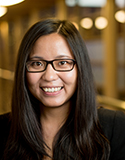 Xuan Zhang, Postdoctoral Fellow
Xuan Zhang, Postdoctoral Fellow
VLSI-Arch Lab
Harvard University
Research Area: Designing Micro-Robotic "Brain": a System-on-Chip (SoC) Approach
The burgeoning field of micro-robotics aims to allow us to build affordable miniature robots that can be deployed in large numbers to perform tasks previously unachievable by humans or larger robots, such as artificial crop pollination. One of the major challenges is to develop an autonomous system within the stringent size and power limitations of a micro-robot. My research takes a System-on-Chip (SoC) approach to building highly-integrated micro-robotic systems. First, the design of a reliable and efficient prototype 'brain' SoC for a bee-sized aerial micro-robot known as a RoboBee is presented. Next, to study the intricate system-level impacts of voltage conversion and supply noise in a robotic SoC, I develop analytical models and tools that enable rapid design space exploration and accurate evaluation of performance and efficiency. In the future, I plan to explore and expand the boundary of fascinating micro-robotic applications in the real world.
Dr. Xuan Zhang received the B. Eng degree from Tsinghua University in China, and the Ph.D. degree from Cornell University. She received an Intel Fellowship in 2008-2009 and won the Design Contest Award at IEEE ISLPED in 2013. She is currently a Postdoctoral Fellow at the Harvard School of Engineering and Applied Sciences. Her research interests include efficient and reliable System-on-Chip for miniaturized autonomous robotics and failure-resilient embedded cyber-physical systems for operation in harsh environments.








